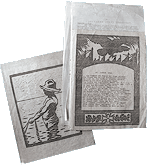KOMMISSIONEN
By their own efforts and persistent negotiations with camp administrators, internees contributed to improved camp conditions. According to the convention for dealing with prisoners of war, the Australian Military provided for an elected committee to deal with the camp’s general welfare.
Several subcommittees, or Kommissionen, were established to oversee education, library, theatre, music, kitchen, bakery, post and, most importantly, the canteen.
The camp Kommissionen ran adult and continuing education programs on science, arts and literature, finance and management. Language courses, held in a separate building called the Berlitz School, included European languages, Chinese and Malay.
The camp’s newspaper, Welt am Montag (World on Monday), played an important role at Trial Bay. It was the only known publication of its kind in Australia, at the time, which was free from censorship, highlighting the extraordinary status and special privileges of the camp. Circulation was by subscription and restricted to the camp.
Theatre company and orchestra
The theatre in Trial Bay opened on 17 August 1916 in a timber barn that seated 280 people. Performances were held on Saturday and Sunday nights. A new play premiered every weekend. The theatre performed 56 plays in 1917. The plays provided a diversion to the daily grind.
The camp’s orchestra also performed there and played an important part in the camp’s social environment. A particularly significant performance was Beethoven’s Fifth Symphony in C-Minor. It was seen as a metaphor of the Great War, of Germany’s fate and a hopeful outcome.
The Trial Bay Internment Camp closureThe Internment Camp was closed in July 1918. Anticipating the end of the war, internees were moved to Holsworthy to prepare for their deportation to Germany. During 1919, 6150 internees were deported from Sydney on various ships.
Another reason for closing the camp was the persistent rumour that the exposed coastal location made it possible for internees to contact passing German vessels. In 1917 it was reported that internees made radio contact with the German raider SMS Wolf while it was in the vicinity. The Royal Australian Naval Intelligence Service warned that an attempt to rescue the prisoners was considered likely and recommended that the camp be closed. This was merely wartime melodrama.
The monument
Before their departure, the internees had built a monument on the hill above Laggers Point, in memory of five comrades who had died while detained. The bodies of three internees were buried at the cairn site: Conrad Peter (1877–1917), Herman I.W. Adam (1879–1915) and Arno Friedrich (1888–1917). It was during the construction of this cairn that the communication with the SMS Wolf was said to have occurred. The cairn was destroyed in July 1919, probably by anti-German vandals. In 1959 the monument was rebuilt as a gesture of post-World War II goodwill, with funds provided by the West German Government and assistance from the Macleay Shire Council and Rotary Club of Kempsey.


